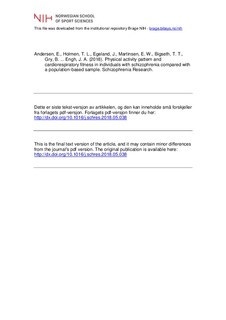Physical activity pattern and cardiorespiratory fitness in individuals with schizophrenia compared with a population-based sample
Andersen, Eivind; Holmen, Tom Langerud; Egeland, Jens; Martinsen, Egil Wilhelm; Bigseth, Therese Torgersen; Bang-Kittilsen, Gry; Anderssen, Sigmund Alfred; Hansen, Bjørge Herman; Engh, John Abel
Journal article, Peer reviewed
Accepted version
Permanent lenke
http://hdl.handle.net/11250/2597043Utgivelsesdato
2018Metadata
Vis full innførselSamlinger
- Artikler / Articles [2119]
- Publikasjoner fra Cristin [1107]
Sammendrag
Objective: Thorough description of objectively assessed physical activity (PA) and sedentary time in people with schizophrenia is lacking, and previous studies comparing PA and cardiorespiratory fitness levels with healthy controls are limited by their small sample size and/or poor methodology. Method: PA, sedentary behavior, and cardiorespiratory fitness level were assessed in 67 adults diagnosed with schizophrenia (EPHAPS study) and compared with a population-based sample of 2809 adults (NPASS study). Results: Fifty-five percent of the participants with schizophrenia had the unhealthy combination of not meeting the PA recommendations and sitting >7.5 h per day compared to 32% in the population-based sample. The PA level was especially low on weekday afternoons and evenings and throughout most of the day on weekends. The peak oxygen uptake for EPHAPS women was on average 23% lower than that for NPASS women, while EPHAPS men achieved on average 34% lower oxygen uptake on the exercise test compared with NPASS men. Conclusion: People with schizophrenia are significantly less physically active, more sedentary, and have a poorer cardiorespiratory fitness level compared with the general population. Tailor-made PA interventions for people with schizophrenia should target their PA and sedentary behavior on afternoons and weekends especially.
Beskrivelse
I Brage finner du siste tekst-versjon av artikkelen, og den kan inneholde ubetydelige forskjeller fra forlagets pdf-versjon. Forlagets pdf-versjon finner du på sciencedirect.com / In Brage you'll find the final text version of the article, and it may contain insignificant differences from the journal's pdf version. The definitive version is available at sciencedirect.com
